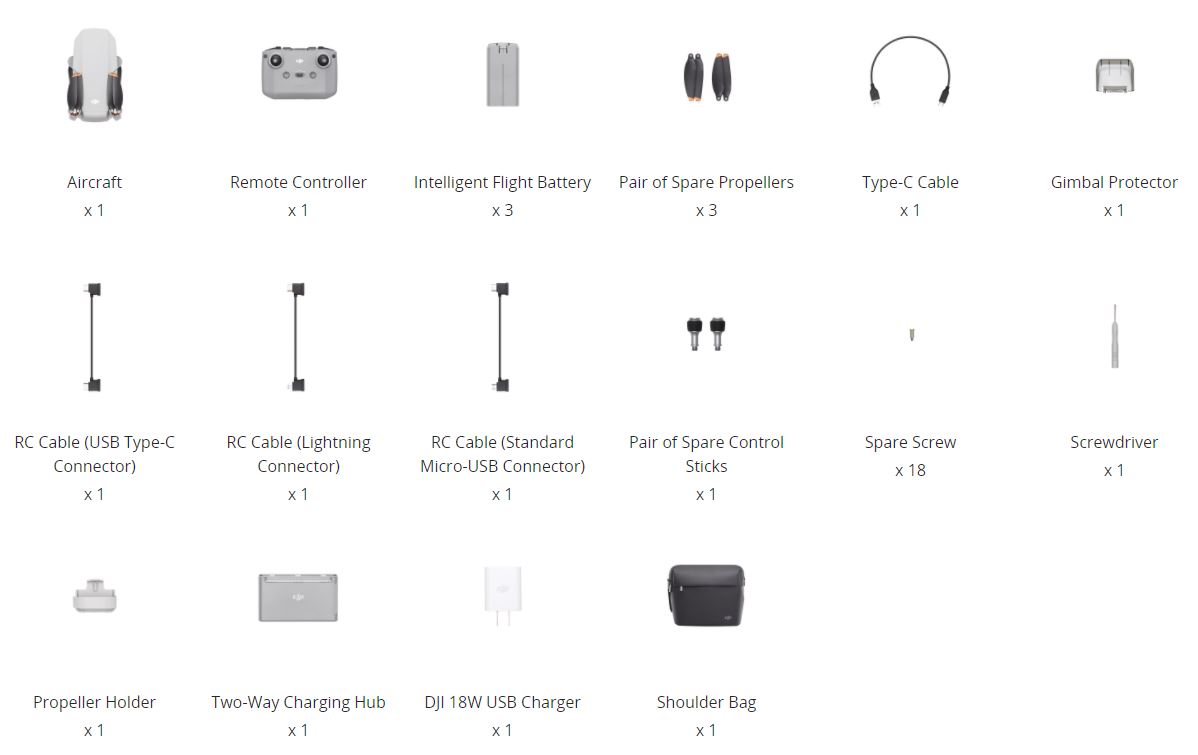Related Items
DJI Mavic Mini 2
Sold Out $749.00
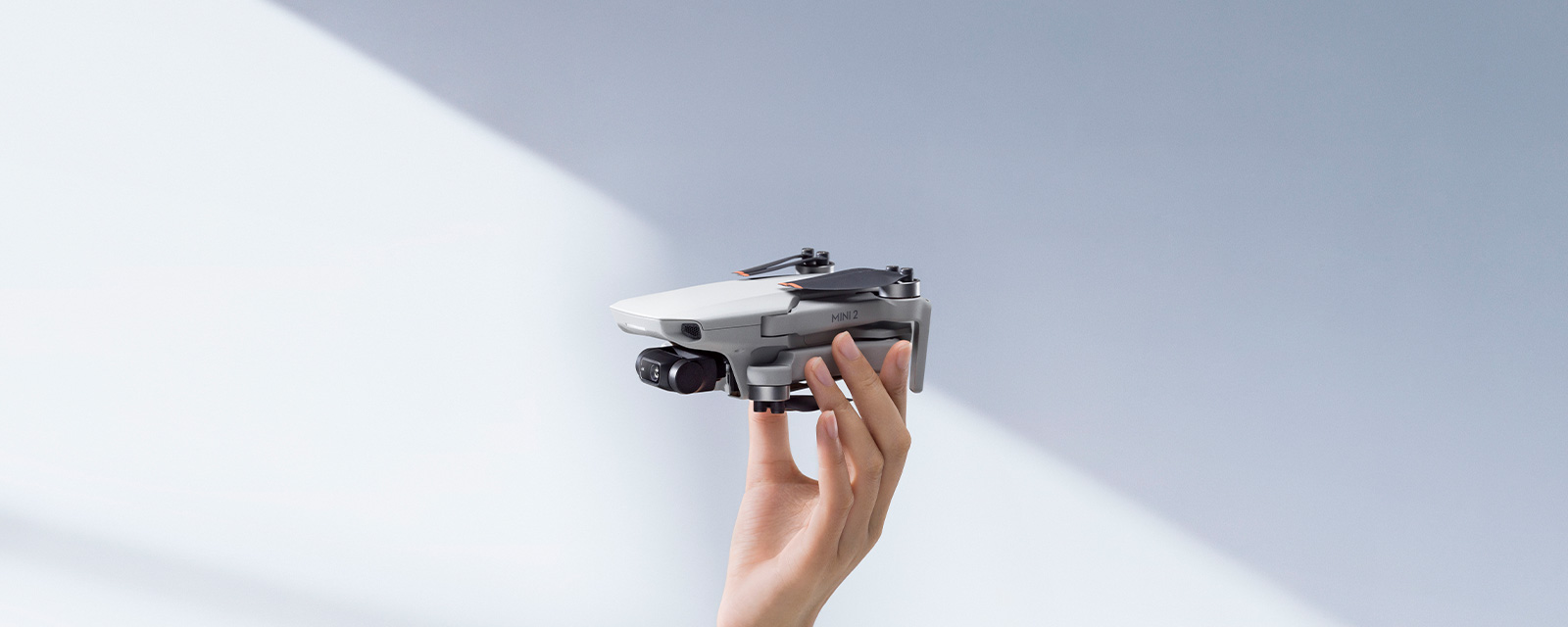
Pack Light, Fly Free
Just how light is DJI Mini 2? At less than 249 g, it weighs about as much as an apple and fits in the palm of your hand. Compact and convenient, Mini 2 is your ideal travel companion, transforming how you capture your favorite memories. [1]
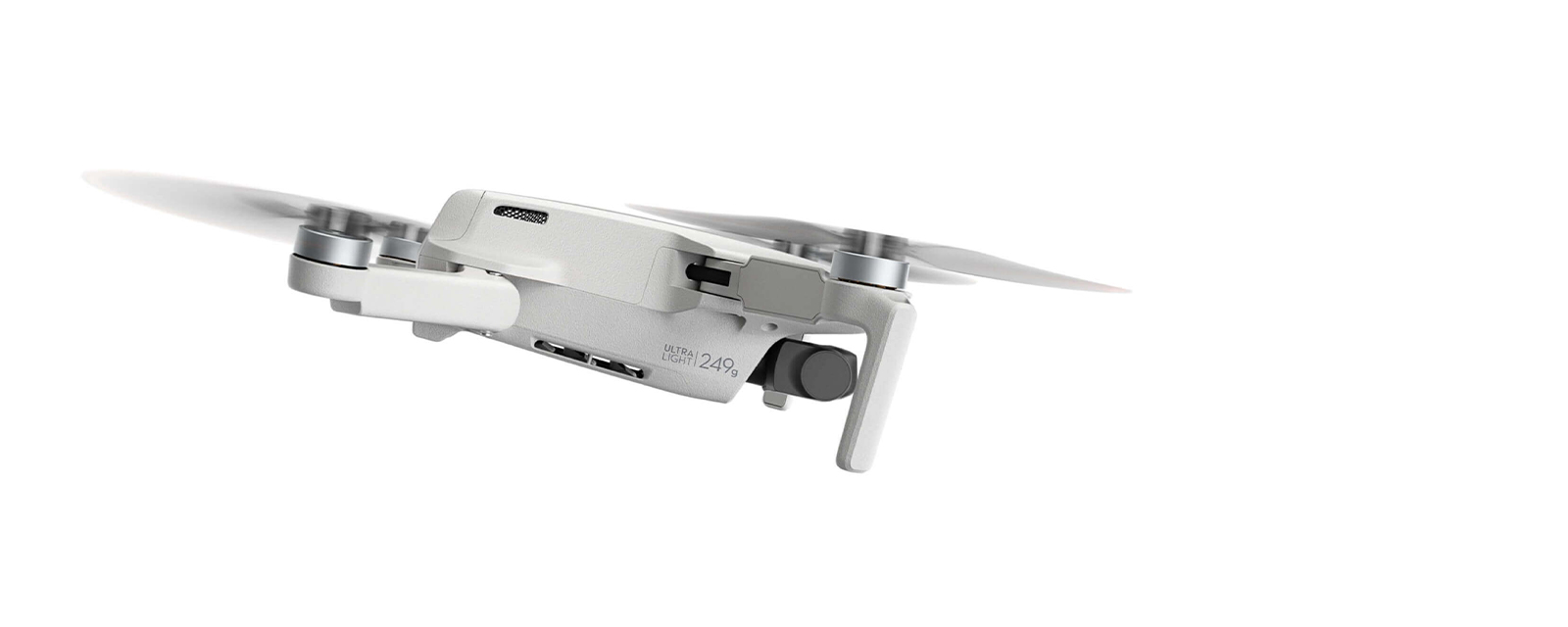
Small But Mighty
Thanks to intuitive and advanced features packed in a portable frame, DJI Mini 2 provides complete freedom wherever and however you want to create. Whether you’re shooting at a deserted beach or capturing the details of a fun family reunion, Mini 2 can handle it all.
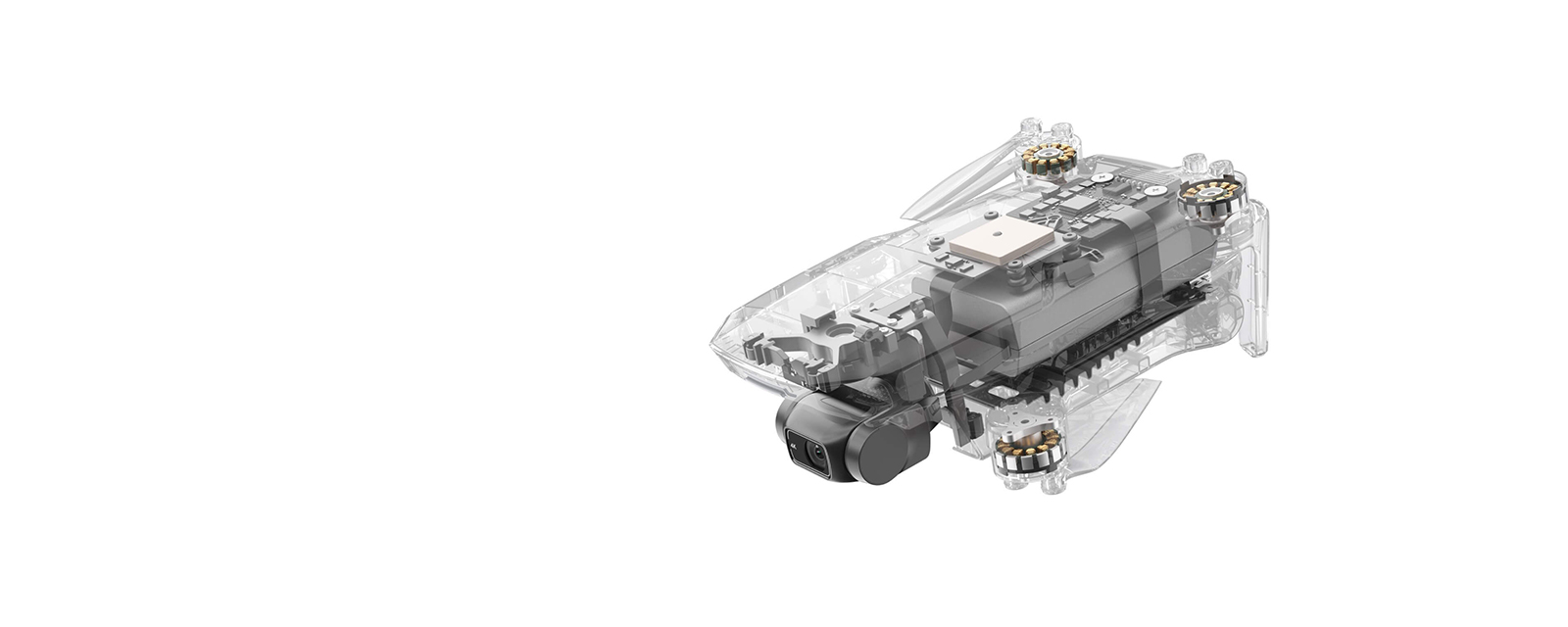
Powerful Performance
It may be small, but this drone packs a ton of power.
With a max battery life of 31 minutes, DJI Mini 2 grants more than enough time to compose the perfect shot. [2]
Mini 2 can resist level 5 winds and take off at a max altitude of 4,000 meters, so your footage is stable even when flying along a windy coastline or high above an alpine forest.
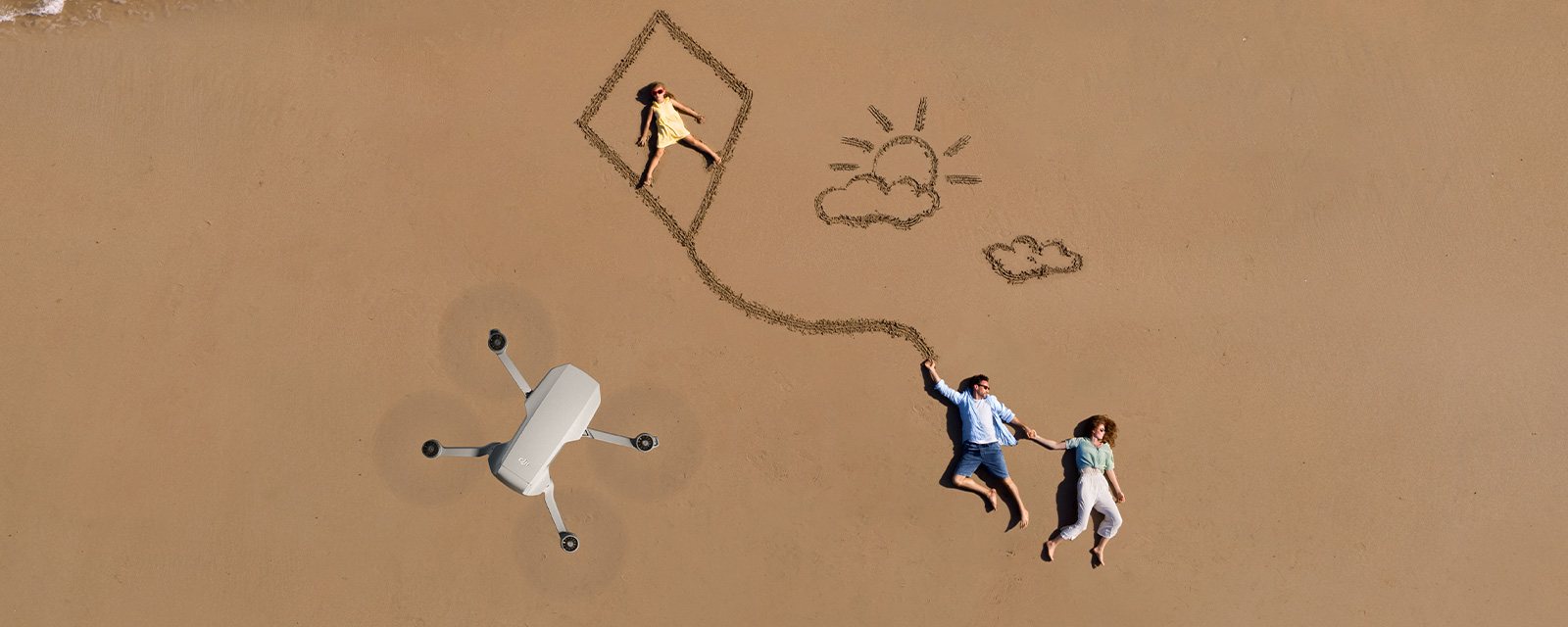
OcuSync 2.0 Video Transmission
Explore your world without limitations.
Mini 2 supports up to 10 km of HD video transmission and has excellent anti-interference capabilities, giving you the ability to fly farther and see clearer. [3]
Relive your best moments through footage that wows.
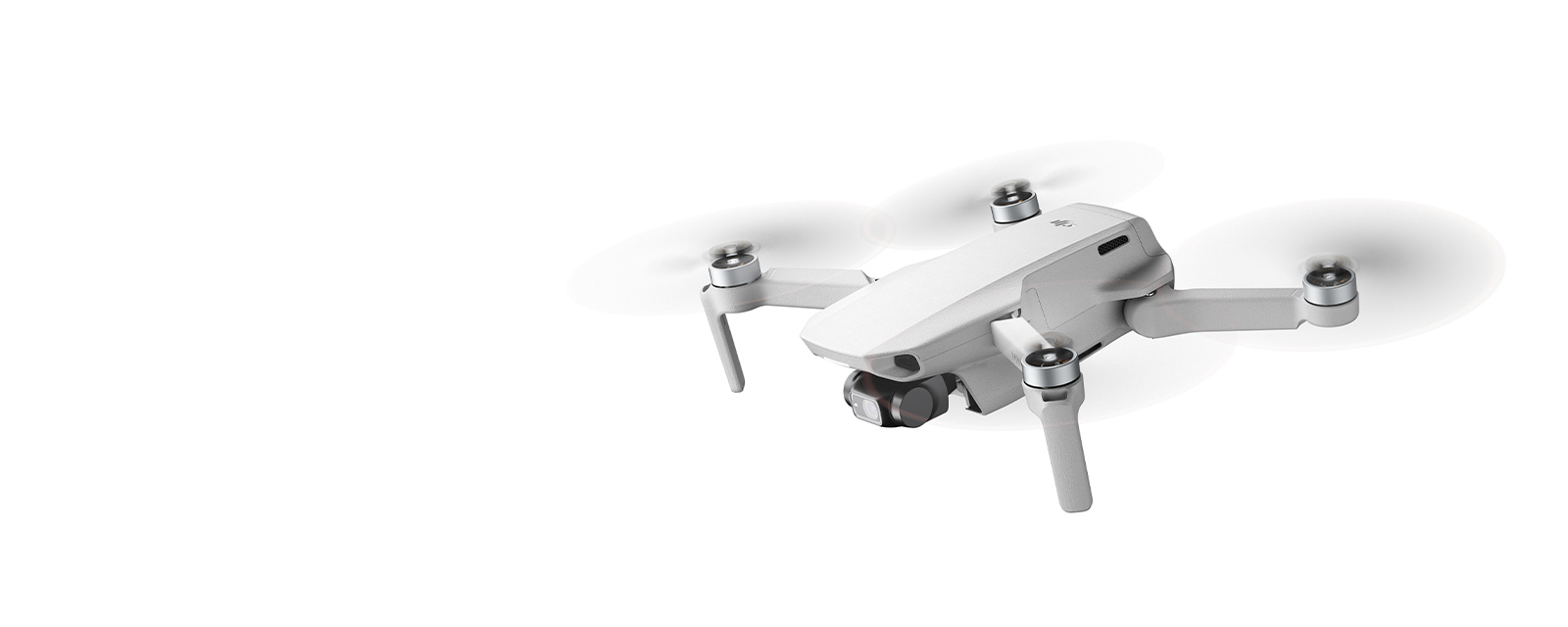
3-Axis Gimbal with 4K Camera
It’s like pressing the replay button on your memories.
A 12MP camera in the sky delivers content guaranteed to impress. Along with 4K/30fps video and a 3-axis motorised gimbal, Mini 2 ensures stunning image quality that is consistently smooth no matter how adventurous your piloting gets.
4x Zoom
There’s no need to get so close for your dream shot.
4x digital zoom makes it safer and more convenient when transitioning between shots of varying distance and composition.
QuickShots
Instantly master aerial photography.
With just a few taps, DJI Mini 2 automatically records and shoots professional-level videos to share directly on social media. Whether you’re a beginner or a more experienced flyer, the DJI Fly app helps you produce impressive results complete with soundtracks and filters.
Panorama
Show off just how epic your view is.
Select from Wide-Angle, 180°, and Sphere panoramas, and DJI Mini 2 will do the rest, generating a panoramic masterpiece almost instantly.

Enhanced Photo
Why wait to share your best photos?
The DJI Fly app features intelligent, built-in photo optimization. The app automatically enhances image quality after downloading a photo, resulting in vivid colours and details that pop.
Simplify your creativity among the clouds and put amazing shots within reach.
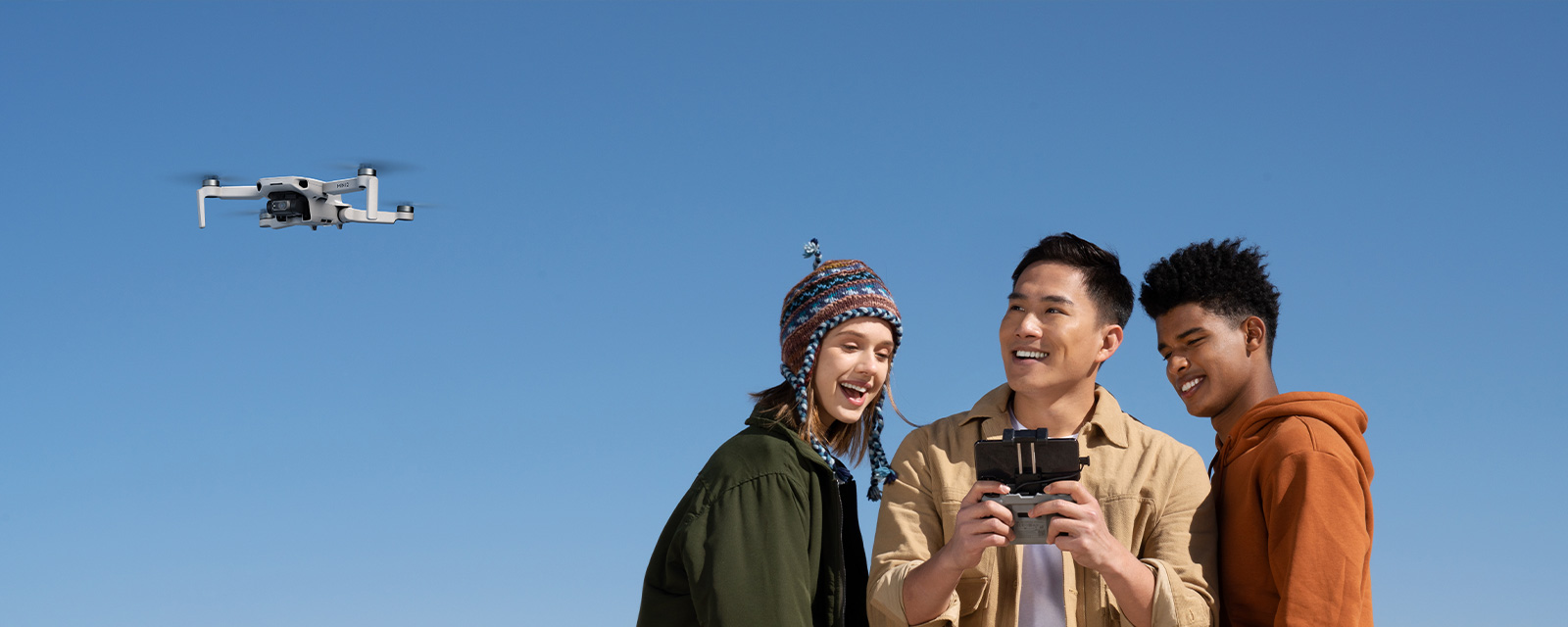
Simplified Flight for Stunning Content
DJI Mini 2 carefully optimizes user experience and intelligent features. Thanks to Smart Return to Home, automatic takeoff, and precise hovering, operation is more streamlined and safer than ever. [4] The possibilities are endless when the sky is your playground.
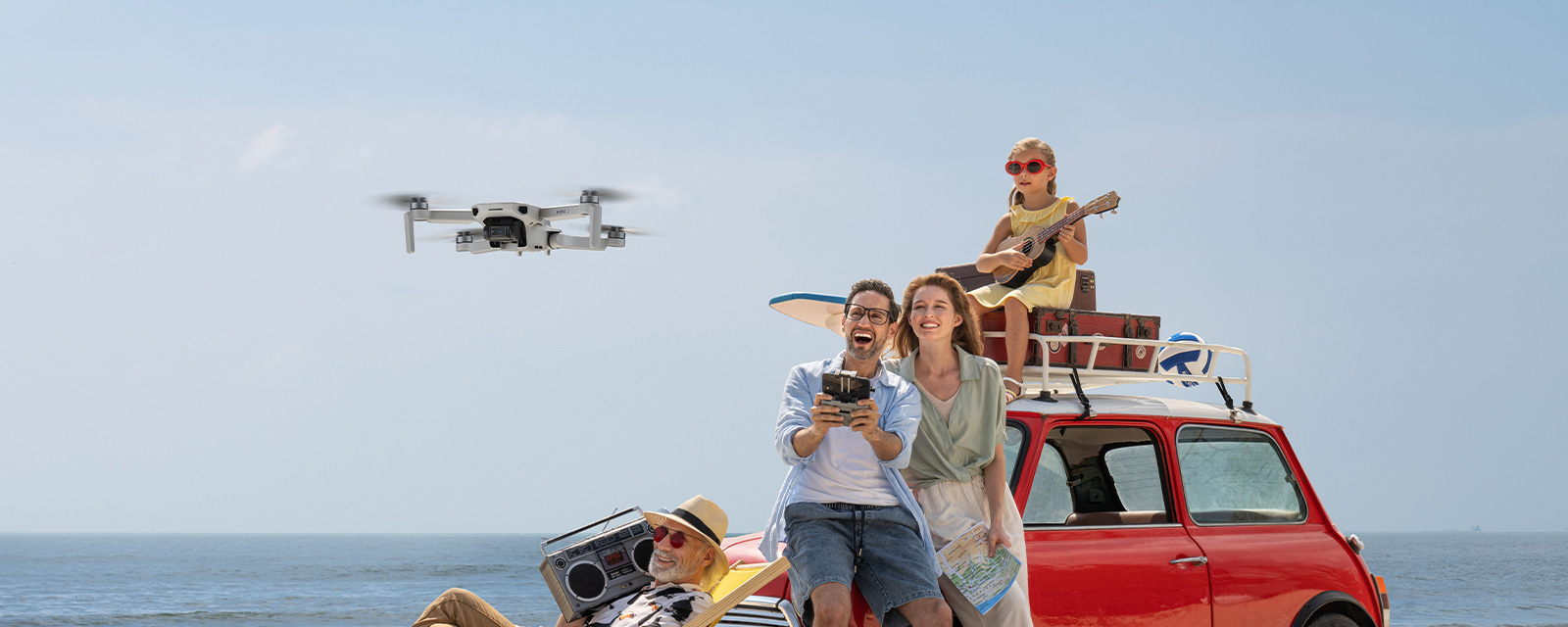
Fly Spots
Discover a new adventure.
Not sure where to fly? Figuring out where to take off no longer needs to be a headache. Plan your itinerary in advance with the DJI Fly app, and you might even come across another aerial photography enthusiast. [5]
QuickTransfer
When Mini 2 is close to your smartphone, the DJI Fly app will automatically recognize and connect to the aircraft and synchronize selected photos and videos at 20 MB/s. [6]
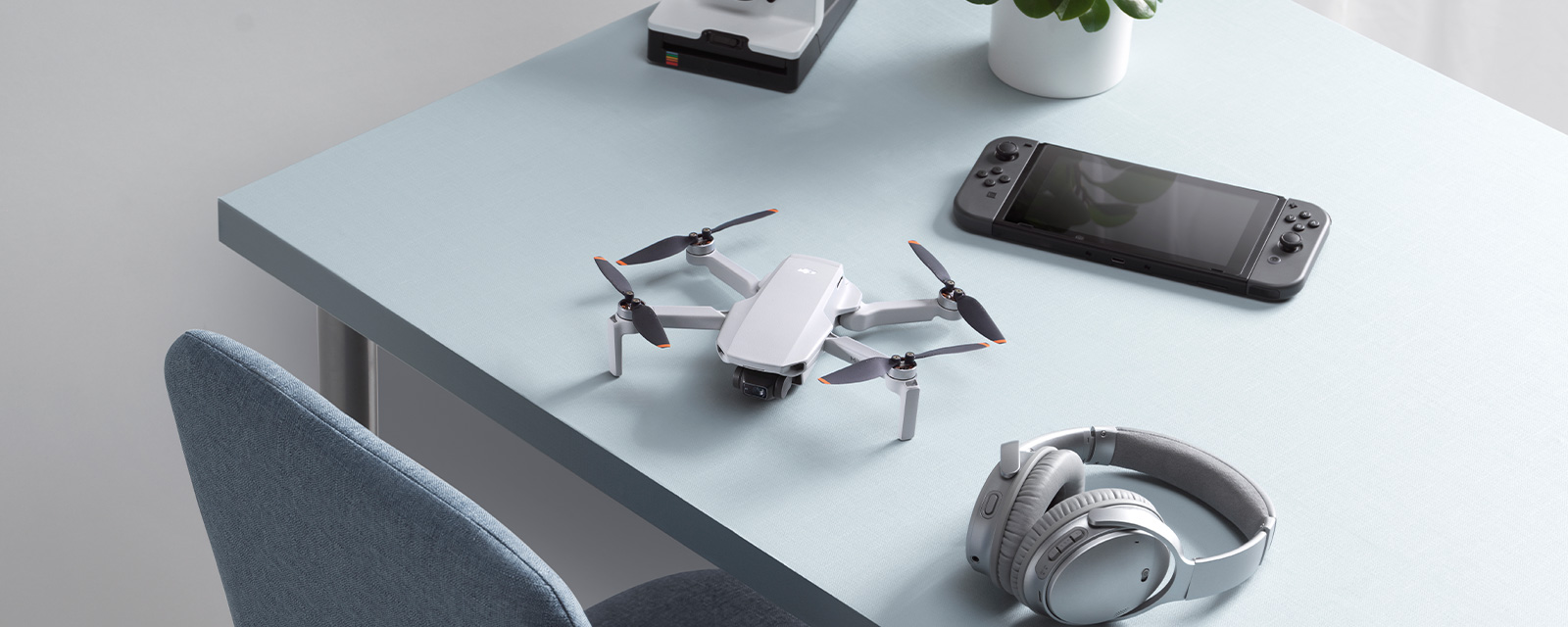
Trimmed Download
With this new feature, you can easily cut out a segment of your footage to edit and download. Hunting for your favorite shot or worrying about insufficient storage is a thing of the past.
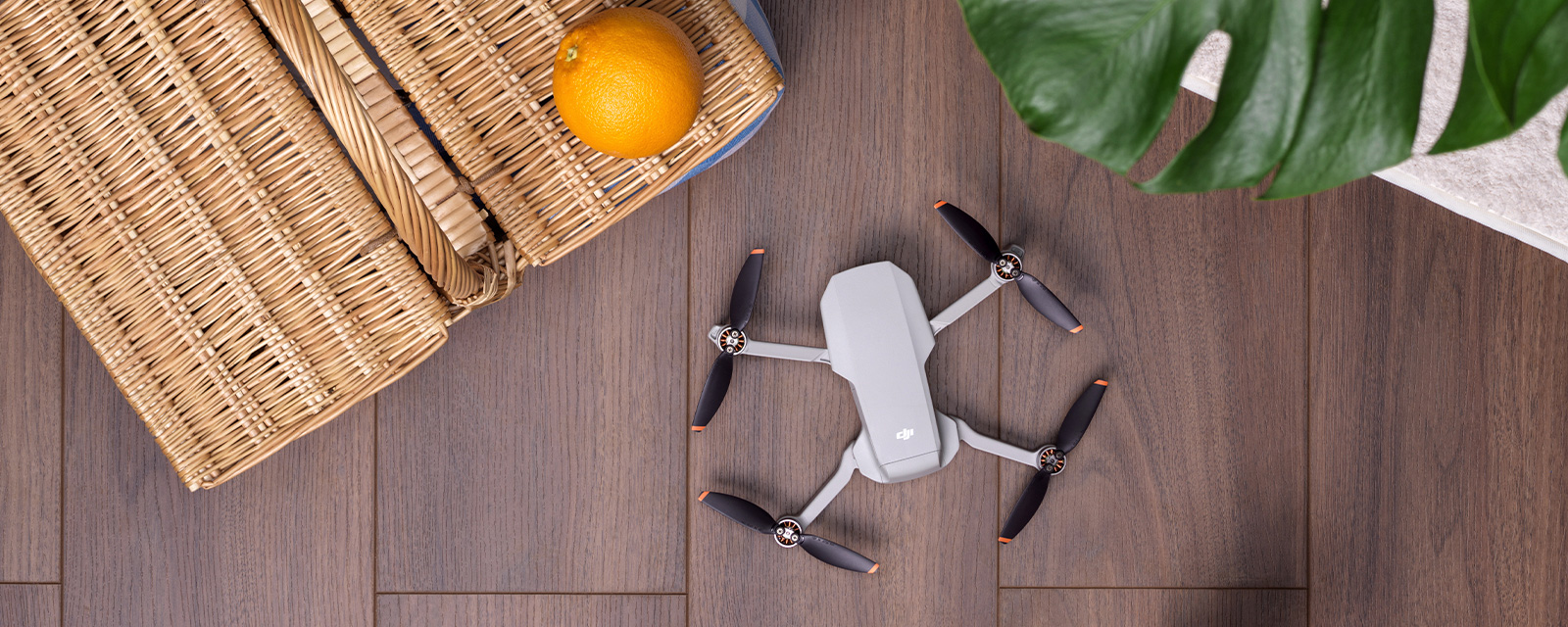
Imaginative Templates
The intuitive editor of the DJI Fly app includes a diverse set of creative templates. Flying, shooting, editing, and sharing can be done almost instantly, allowing you to create and share on the go.
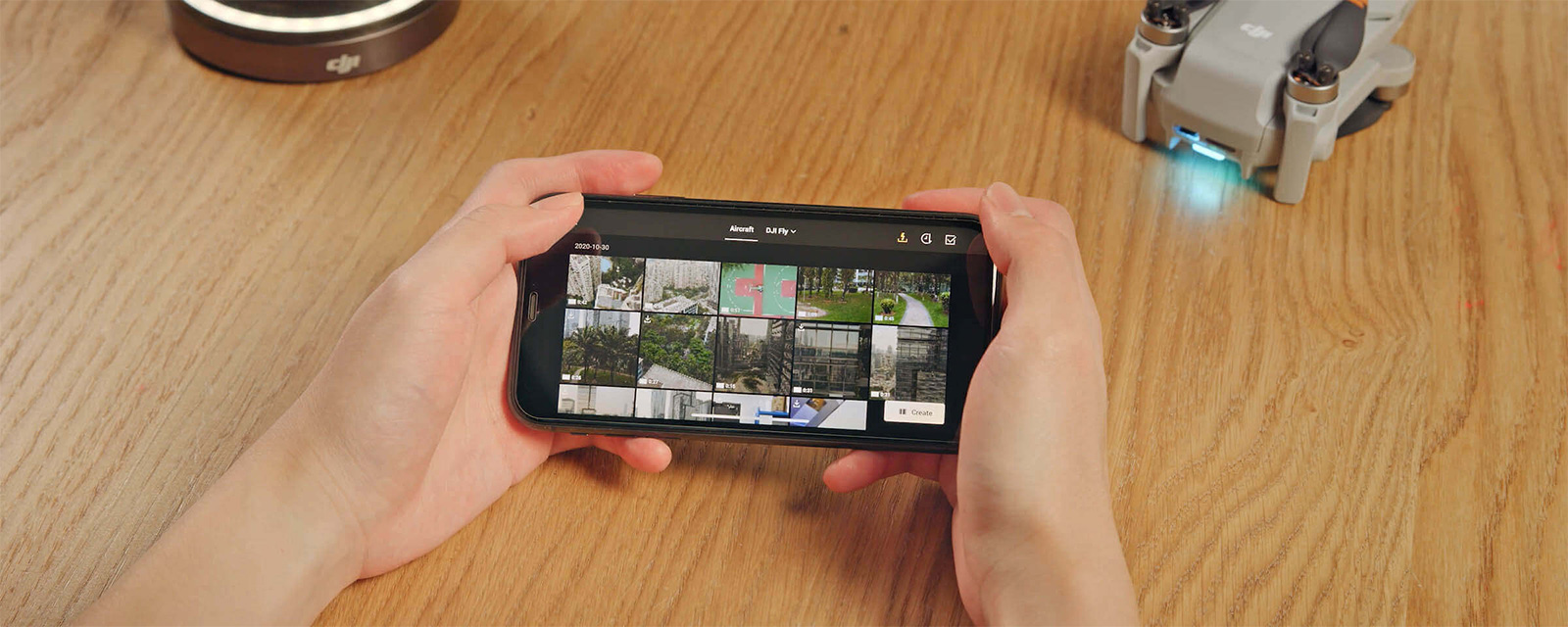
1. Aircraft takeoff weight includes the battery, propellers, and a microSD card. Check all applicable rules and regulations before use and always fly safely near others.
2. Measured at a constant speed of 14 kph in windless conditions.
3. Unobstructed, free of interference, and when FCC-compliant. Maximum flight range specification is a proxy for radio link strength and resilience. It only refers to the maximum, one-way flight distance without considering Return to Home. Always follow local rules and regulations and fly your drone within your visual line of sight unless otherwise permitted.
4. Vision positioning requires non-reflective, discernable surfaces, and adequate lighting. Available at altitudes from 0.5-30 m. The vertical and horizontal positioning accuracy is within ±0.1 m.
5. Currently, Fly Spots are only available in China.
6. This data is the highest download speed in the 5.8GHz frequency band. When using the QuickTransfer function in the 2.4GHz frequency band, the maximum download speed is 6 MB/s.
* The parameters listed on this page were all measured in a controlled test environment. Results may vary; please refer to the actual product experience.
** All relevant laws and regulations were observed when shooting the photo and video content displayed on this website.
|
Takeoff Weight [1] |
< 249 g |
|
Dimensions |
Folded: 138×81×58 mm (L×W×H) |
|
Dimensions |
Unfolded: 159×203×56 mm (L×W×H) |
|
Dimensions |
Unfolded (with propellers): 245×289×56 mm (L×W×H) |
|
Diagonal Distance |
213 mm |
|
Max Ascent Speed |
5 m/s (S Mode) |
|
Max Ascent Speed |
3 m/s (N Mode) |
|
Max Ascent Speed |
2 m/s (C Mode) |
|
Max Descent Speed |
3.5 m/s (S Mode) |
|
Max Descent Speed |
3 m/s (N Mode) |
|
Max Descent Speed |
1.5 m/s (C Mode) |
|
Max Speed (near sea level, no wind) |
16 m/s (S Mode) |
|
Max Speed (near sea level, no wind) |
10 m/s (N Mode) |
|
Max Speed (near sea level, no wind) |
6 m/s (C Mode) |
|
Max Service Ceiling Above Sea Level |
4000 m |
|
Max Service Ceiling Above Sea Level |
(2000 m when taking off with propeller guard) |
|
Max Flight Time |
31 mins (measured while flying at 4.7 m/s in windless conditions) |
|
Max Wind Speed Resistance |
8.5-10.5 m/s (Scale 5) |
|
Max Tilt Angle |
40° (S Mode) |
|
Max Tilt Angle |
25° (N Mode)* |
|
Max Tilt Angle |
25° (C Mode)* |
|
Max Tilt Angle |
* Up to 40° under strong winds |
|
Max Angular Velocity (by default)* |
130°/s (S Mode) |
|
Max Angular Velocity (by default)* |
60°/s (N Mode) |
|
Max Angular Velocity (by default)* |
30°/s (C Mode) |
|
Max Angular Velocity (by default)* |
* Can be adjusted to 250°/s with the DJI Fly app |
|
Operating Temperature |
0° to 40°C (32° to 104°F) |
|
Operating Frequency [2] |
2.400-2.4835 GHz, 5.725-5.850 GHz |
|
Transmitter Power (EIRP) |
2.400-2.4835 GHz |
|
Transmitter Power (EIRP) |
FCC ≤ 26 dBm |
|
Transmitter Power (EIRP) |
CE ≤ 20 dBm |
|
Transmitter Power (EIRP) |
SRRC ≤ 20 dBm |
|
Transmitter Power (EIRP) |
MIC ≤ 20 dBm |
|
Transmitter Power (EIRP) |
5.725-5.850 GHz |
|
Transmitter Power (EIRP) |
FCC ≤ 26 dBm |
|
Transmitter Power (EIRP) |
CE ≤ 14 dBm |
|
Transmitter Power (EIRP) |
SRRC ≤ 26 dBm |
|
Global Navigation Satellite System (GNSS) |
GPS+GLONASS+GALILEO |
|
Hovering Accuracy Range |
Vertical: ±0.1 m (with Vision Positioning), ±0.5 m (with GPS Positioning) |
|
Hovering Accuracy Range |
Horizontal: ±0.3 m (with Vision Positioning), ±1.5 m (with GPS Positioning) |
|
Mechanical Range |
Tilt: -110° to 35° |
|
Mechanical Range |
Roll: -35° to 35° |
|
Mechanical Range |
Pan: -20° to 20° |
|
Controllable Range |
Tilt: -90° to 0° (default setting) |
|
Stabilization |
3-axis (tilt, roll, pan) |
|
Max Control Speed (tilt) |
100°/s |
|
Angular Vibration Range |
±0.01° |
|
Downward |
Hovering Range: 0.5-10 m |
|
Operating Environment |
Non-reflective, discernable surfaces |
|
Operating Environment |
Diffuse reflectivity (> 20%,such as cement pavement) |
|
Operating Environment |
Adequate lighting (lux > 15, Normal exposure environment of indoor fluorescent lamp) |
|
Sensor |
1/2.3” CMOS |
|
Sensor |
Effective Pixels: 12 MP |
|
Lens |
FOV: 83° |
|
Lens |
35 mm format equivalent: 24 mm |
|
Lens |
Aperture: f/2.8 |
|
Lens |
Focus range: 1 m to ∞ |
|
ISO |
Video: |
|
ISO |
100-3200 (Auto) |
|
ISO |
100-3200 (Manual) |
|
ISO |
Photos: |
|
ISO |
100-3200 (Auto) |
|
ISO |
100-3200 (Manual) |
|
Shutter Speed |
Electronic Shutter: 4-1/8000 s |
|
Max Image Size |
4:3: 4000×3000 |
|
Max Image Size |
16:9: 4000×2250 |
|
Still Photography Modes |
Single Shot |
|
Still Photography Modes |
Interval: |
|
Still Photography Modes |
JPEG+RAW: 5/7/10/15/20/30/60 s |
|
Still Photography Modes |
Auto Exposure Bracketing (AEB): 3 bracketed frames at 2/3 EV Bias |
|
Still Photography Modes |
Panorama: Sphere, 180°, and Wide |
|
Video Resolution |
4K: 3840×2160 @ 24/25/30fps |
|
Video Resolution |
2.7K: 2720×1530 @ 24/25/30fps |
|
Video Resolution |
FHD: 1920×1080 @ 24/25/30/48/50/60fps |
|
Max Video Bitrate |
100 Mbps |
|
Zoom Range |
4K: 2x |
|
Zoom Range |
2.7K: 3x |
|
Zoom Range |
FHD: 4x |
|
QuickShot Modes |
Dronie, Helix, Rocket, Circle, Boomerang |
|
Supported File Formats |
FAT32 (≤ 32 GB) |
|
Supported File Formats |
exFAT (> 32 GB) |
|
Photo Formats |
JPEG/DNG (RAW) |
|
Video Formats |
MP4 (H.264/MPEG-4 AVC) |
|
Operating Frequency |
2.400-2.4835 GHz, 5.725-5.850 GHz |
|
Max Transmission Distance (unobstructed, free of interference) [3] |
10 km (FCC) |
|
Max Transmission Distance (unobstructed, free of interference) [3] |
6 km (CE) |
|
Max Transmission Distance (unobstructed, free of interference) [3] |
6 km (SRRC) |
|
Max Transmission Distance (unobstructed, free of interference) [3] |
6 km (MIC) |
|
Signal Transmission Ranges (FCC) [4] |
Strong Interference (urban landscape, limited line of sight, many competing signals): Approx. 3 km |
|
Signal Transmission Ranges (FCC) [4] |
Medium Interference (suburban landscape, open line of sight, some competing signals): Approx. 6 km |
|
Signal Transmission Ranges (FCC) [4] |
Low Interference (open landscape abundant line of sight, few competing signals): Approx. 10 km |
|
Operating Temperature |
10° to 40° C (14° to 104° F) |
|
Transmission Power (EIRP) |
2.400-2.4835 GHz |
|
Transmission Power (EIRP) |
FCC ≤ 26 dBm |
|
Transmission Power (EIRP) |
CE ≤ 20 dBm |
|
Transmission Power (EIRP) |
SRRC ≤ 20 dBm |
|
Transmission Power (EIRP) |
MIC ≤ 20 dBm |
|
Transmission Power (EIRP) |
5.725-5.850 GHz |
|
Transmission Power (EIRP) |
FCC ≤ 26 dBm |
|
Transmission Power (EIRP) |
CE ≤ 14 dBm |
|
Transmission Power (EIRP) |
SRRC ≤ 26 dBm |
|
Battery Capacity |
5200 mAh |
|
Voltage |
1200 mA 3.7 V (Android) |
|
Voltage |
700 mA 3.7 V (iOS) |
|
Supported Mobile Device Size |
Max length: 92 mm |
|
Supported USB Port Types |
Lightning |
|
Video Transmission System |
OcuSync 2.0 |
|
Live View Quality |
Remote Controller: 720p/30fps |
|
Max Bitrate |
8 Mbps |
|
Latency (depending on environmental conditions and mobile device) |
about 200 ms |
|
Input |
100-240 V, 50/60 Hz, 0.5 A |
|
Output |
12V 1.5 A / 9V 2A / 5V 3A |
|
Rated Power |
18 W |
|
Battery Capacity |
2250 mAh |
|
Voltage |
7.7 V |
|
Charging Voltage Limit |
8.8 V |
|
Battery Type |
LiPo 2S |
|
Energy |
17.32 Wh |
|
Weight |
86.2 g |
|
Charging Temperature |
5° to 40°C (41° to 104°F) |
|
Max Charging Power |
29 W |
|
Name |
DJI Fly |
|
Required Operating System |
iOS v10.0 or later |
|
Supported SD Cards |
UHS-I Speed Class 3 or above is required. A list of recommended microSD cards can be found below. |
|
Recommended microSD Cards |
16 GB: SanDisk Extreme |
|
Recommended microSD Cards |
32 GB: Samsung Pro Endurance, Samsung Evo Plus, SanDisk Industrial, SanDisk Extreme V30 A1, SanDisk Extreme V30 A2, SanDisk Extreme Pro V30 A1, SanDisk Extreme Pro V30 A2, Lexar 633x, Lexar 667x |
|
Recommended microSD Cards |
64 GB: Samsung Pro Endurance, Samsung Evo Plus, SanDisk Extreme V30 A1, SanDisk Extreme V30 A2, Lexar 633x, Lexar 667x, Lexar 1000x, Lexar High Endurance, Toshiba EXCERIA M303 V30 A1, Netac Pro V30 A1 |
|
Recommended microSD Cards |
128 GB: Samsung Pro Plus, Samsung Evo Plus, SanDisk Extreme V30 A1, SanDisk Extreme V30 A2, SanDisk Extreme Plus V30 A1, SanDisk Extreme Plus V30 A2, Lexar 633x, Lexar 667x, Lexar 1000x, Lexar High Endurance, Toshiba EXCERIA M303 V30 A1, Netac Pro V30 A1 |
|
Recommended microSD Cards |
256 GB: SanDisk Extreme V30 A1, SanDisk Extreme V30 A2 |
|
Footnotes |
1. The standard weight of the aircraft (including battery, propellers, and a microSD card) is 242 grams. Actual poduct weight may vary. Registration is not required in some countries and regions. Check local rules and regulations before use. These specifications have been determined through tests conducted with the latest firmware. Firmware updates can enhance performance, so updating to the latest firmware is highly recommended. |
|
Footnotes |
2. Due to local policy and regulation restrictions, the 5.8 GHz frequency band is currently banned in certain countries, including but not limited to Japan, Russia, Israel, Ukraine, and Kazakhstan. Please use the 2.4 GHz frequency band when operating in these locations. Always check local rules and regulations before use, as they may change over time. |
|
Footnotes |
3. Maximum flight range specification is a proxy for radio link strength and resilience, not aircraft battery capability. It only refers to the maximum, one-way flight distance. Data was measured in an open environment without interference. Please pay attention to the return prompt on the DJI Fly app during actual flight. Refer to the following applicable standard in different countries and regions: |
|
Footnotes |
4. Data is tested under different standards in open areas free of interference. It only refers to the maximum, one-way flight distance without considering Return to Home. Please pay attention to RTH prompts in the DJI Fly app during actual flight. |
FAQs
|
What color options are available for DJI Mini 2? |
Currently, light gray is the only color option for DJI Mini 2. However, the DIY Creative Kit is available, which can be used to personalize and decorate DJI Mini 2. The DIY Creative Kit can be purchased separately at the DJI Online Store. |
|
What is the weight of DJI Mini 2? |
The standard weight of the aircraft (including battery, propellers, and a microSD card) is 242 grams. Actual product weight may vary. Registration is not required in some countries and regions. Check local rules and regulations before use. |
|
How do I turn on a DJI Mini 2 after unboxing? |
To ensure transportation safety, DJI Mini 2 flight batteries are set to Sleep mode before shipping. Simply connect the aircraft with the battery charger to activate the battery and begin using. After activating the battery, press the power button once and then press and hold to turn on the aircraft. |
|
What app does DJI Mini 2 work with? Where can I download it? What mobile devices is the app compatible with? |
DJI Mini 2 can only be used with the DJI Fly app. |
|
How do I activate DJI Mini 2? |
Connect your mobile device with the remote controller, then connect with DJI Mini 2 via the DJI Fly app. Follow the app instructions to activate DJI Mini 2. |
|
I am a beginner, where can I find tips about using DJI Mini 2? |
DJI Mini 2 comes with a user manual and comprehensive tutorials, which you can get from the Flight Academy in the DJI Fly app.You can follow DJI Support on Facebook and Twitter to get more tips on using DJI Mini 2. |
|
Does DJI Mini 2 have internal storage? Can I install a microSD card? If yes, what kinds of microSD cards are recommended? |
No. A microSD card is required in order to store images and footage. Recommended microSD cards are: |
|
Can I take photos or video without a microSD card? |
Yes. However, when a microSD card is not installed, the photos or videos you take will be of a lower resolution (720p). It is recommended to install a microSD card before shooting. |
|
Is Mavic Mini waterproof? |
No. |
|
Does Mavic Mini support obstacle avoidance? |
No. Use Mavic Mini with the 360° Propeller Guard to fully protect the propellers and improve flight safety. (Recommendation of 360° Propeller Guard shall not appear in FAQ for European websites.) |
|
Does DJI Mini 2 support automatic Return to Home (RTH)? |
Yes. Always be sure to observe the surrounding environment carefully and set a proper altitude to avoid obstacles when using the Return to Home function. |
|
Can DJI Mini 2 track objects automatically? |
No. |
|
Is there a way to apply to fly in a restricted zone? |
Yes. You can apply for permission to operate in restricted flight areas using the DJI Fly app. Apply by tapping “Unlock GEO Zone” in the DJI Fly app, or fill in the required information at https://www.dji.com/cn/flysafe/custom-unlock. |
|
What is the difference between the international version and Japanese version of DJI Mini 2? |
The international version of DJI Mini 2 differs from the Japanese version in weight, operating time, battery, and propellers. |
|
Does DJI Mini 2 comes in different versions for single frequency band and dual frequency bands? |
No. DJI Mini 2 supports 2.4 GHz and 5.8 GHz simultaneously. In areas that support both frequency bands, DJI Mini 2 switches to the optimal frequency band and channel according to the signal conditions. |
|
What are the main upgrades of DJI Mini 2 compared to Mavic Mini? |
Motors, image transmission, camera performance, intelligent features, and user experience have all improved significantly. The image transmission system is particularly impressive as it has been upgraded to OcuSync 2.0 from enhanced Wi-Fi. An optimized operation process also makes DJI Mini 2 more intuitive. |
|
How is DJI Mini 2 different from Mavic Mini in appearance? |
The design has not changed drastically. The main differences are DJI Mini 2 has orange propeller tips, an additional front light, "4K" printed on the lens, a clickable aircraft status indicator, and smoother connection between the rear arm and the aircraft frame. |
|
Are remote controllers of DJI Mini 2 and Mavic Mini interchangeable? |
No. |
|
Are batteries of DJI Mini 2 and Mavic Mini interchangeable? |
No. Mavic Mini will not function with the battery of DJI Mini 2. Although the international version of DJI Mini 2 can use Mavic Mini’s battery, the power will decrease and the total weight will exceed 250 g, requiring registration in some countries and regions. Please check local rules and regulations before use. |
|
Are remote controllers of DJI Mini 2 and Mavic Air 2 interchangeable? |
Yes. Update DJI Mini 2 in DJI Fly app to the firmware version 1.1.0.0 or above; Update DJI Mavic Air 2 to the firmware version 1.0.4.60 or above. After firmware update, the remote controller can connect both aircrafts. |
|
What are the major parameters of DJI Mini 2's camera? |
DJI Mini 2 is equipped with a 1/2.3-inch CMOS sensor with up to 12 million effective pixels. |
|
What are the maximum photo and video resolutions supported by DJI Mini 2? |
Photo Resolutions |
|
Can DJI Mini's camera zoom? How can I use it? |
DJI Mini 2 supports digital zoom, namely: |
|
What photo modes does DJI Mini 2 support? |
Single Shot, Interval and AEB Triple Shot. |
|
Does DJI Mini 2 support portrait mode? |
No. |
|
Does DJI Mini 2 support panorama? |
Yes. It supports Sphere, 180°, and Wide-Angle. |
|
Does DJI Mini 2 support RAW photos? |
Yes. |
|
Does DJI Mini 2 support manual mode in taking photos and videos? |
Yes. You can adjust shutter, ISO, and white balance in M mode. |
|
Does Mavic Mini support QuickShots? |
Yes. The DJI Fly app QuickShots modes include Dronie, Helix, Rocket, Circle, and Boomerang. |
|
How does DJI Mini 2 provide stabilization? |
By 3-axis (tilt, roll and pan) motorized gimbal stabilization. |
|
Can I replace the gimbal of DJI Mini 2 by myself? |
No. |
|
What advantages does Ocusync 2.0 of DJI Mini 2 have over enhanced Wi–Fi in image transmission? |
OcuSync 2.0 supports both 2.4 GHz and 5.8 GHz frequency bands. It features stronger interference resistance due to automatic frequency switching, delivering video transmission feeds at up to 10 km (when unobstructed, free of interference, and FCC-compliant). |
|
What is DJI Mini 2’s maximum video transmission resolution? |
|
|
Does the remote controller support HDMI? |
No. |
|
What is the maximum width of mobile device supported by the DJI Mini 2 remote controller? |
92 mm. |
|
How can I improve signal reception? |
The smartphone clamp of the remote controller houses the antennas. Make sure that the antennas are pointed toward the aircraft. Check the user manual for more information about setting the antenna direction. Additionally, 2.4/5.8 GHz wireless devices can cause interference to the signal. Please avoid high-density Wi-Fi signal sources, and consider turning off the Bluetooth on your mobile devices, as well as idle Bluetooth devices. |
|
What is QuickTransfer? How do I use it? |
QuickTransfer is an all-new feature of DJI Mini 2. It allows users to quickly transfer photos and videos in the DJI Fly app to the mobile device. With QuickTransfer, users can access the album of the aircraft in the DJI Fly app on the mobile device without connecting to the remote controller, and download photos and videos at 20 MB/s. |
|
What is the maximum flight time of DJI Mini 2? |
31 minutes (measured while flying at 4.7 m/s in windless conditions). |
|
What is the maximum flight altitude of DJI Mini 2? |
The maximum flight altitude is 500 m, which may vary in different countries and regions due to local laws. Before flying, please check local laws and regulations. |
|
Do I have to remove the propellers for storage and transportation? |
No. Please do not bend the propellers as it may affect the flight performance. We recommend using the 360° Propeller Guard for protection when storing. |
|
How often do DJI Mini 2 propellers need to be replaced? How can I change the propellers of DJI Mini 2? |
Before each flight, it is necessary to check the propellers for cracks, wear, warp, corrosion, and loose screws. If any of these conditions are present, the propellers should be replaced. Follow the instructions in the user manual to replace the propellers. |
|
What is the maximum wind resistance level of DJI Mini 2? |
DJI Mini 2 can hover stably at in wind speeds of up to 8.5-10.5 m/s. |
|
What is DJI Mini 2’s maximum service ceiling? |
The maximum service ceiling is 4000 m. |
|
What do I need to know before installing the 360° Propeller Guard? (Not applicable for Europe) |
Do not use the 360° Propeller Guard in a windy environment or at an altitude above 2000 m. After attaching the 360° Propeller Guard, there will be restrictions on flight distance and flight altitude. Please refer to the specifications in the DJI Fly app. (Not applicable for Europe) |
|
How can I charge DJI Mini 2? |
You can connect the aircraft to a charger with Type-C cable, or use the Two-Way Charging Hub. |
|
Does DJI Mini 2 have special requirement for the charger? Does it support fast charging? |
DJI Mini 2 does not have special requirements for the charger. You can use an ordinary USB charger. |
|
What are the functions of the Two-Way Charging Hub? |
The DJI Mini 2 Two-Way Charging Hub supports QC and USB PD fast-charging protocols, and can charge up to three batteries in sequence. You can also use it for battery storage or as a power bank to charge your mobile device or remote controller via the USB-A port. |
|
How do I maintain DJI Mini 2 batteries? |
Before storage, it is recommended to charge the battery to approximately 72%. It is recommended to charge and discharge the battery once every three months to improve battery performance. If the battery level is below 72%, it is recommended to charge it until it is 72% before storing. If the battery level is above 72%, the battery will discharge automatically after 5 days to 72%. |
|
Does DJI Mini 2 aircraft upgrade require remote controller? Can I upgrade the aircraft by connecting it to smartphone? |
Updating requires the remote controller instead of your smartphone. You can also download DJI Assistant 2 (Consumer Drones Series) on your computer, and connect the aircraft to the computer to start updating. Download DJI Assistant 2 (Consumer Drones Series) via https://www.dji.com/mini-2/downloads. |
|
Can I use other apps while upgrading DJI Mini 2 on the DJI Fly app? |
No. If you do, the update will fail. You will then need to download the firmware and update it again. |
|
Can I disconnect from the Internet once the firmware has been downloaded? |
Yes. |
|
What should I do if aircraft and battery firmware versions are inconsistent? |
Connect DJI Mini 2 to the DJI Fly app. The app will then check firmware compatibility automatically. You should update according to the instructions. |
|
What factors could lead to an upgrade failure? |
a. Low battery. Before installing an update, make sure the battery level of the aircraft is above 15% and that of the remote controller is above 20%. |
|
What Mavic Mini accessories can be used with DJI Mini 2? |
The Mavic Mini DIY Creative Kit, Mavic Mini Snap Adapter, Mavic Mini Propeller Holder, and Mavic Mini Intelligent Flight Battery of the international version of Mavic Mini are compatible with the international version of DJI Mini 2. Although the international version of DJI Mini 2 can use Mavic Mini’s battery, the power will decrease and the total weight will exceed 250 g, requiring registration in some countries and regions. Please check local rules and regulations before use. |
|
Can Mavic Mini use the battery of DJI Mini 2? |
No. |
|
Are DJI Mini 2 Two-Way Charging Hub and Mavic Mini Two-Way Charging Hub interchangeable? |
No. The Two-Way Charging Hub of Mavic Mini cannot charge the batteries of DJI Mini 2, whereas that of DJI Mini 2 can charge the batteries of Mavic Mini. |
|
Can DJI Mini 2 remote controller use accessories of Mavic Mini remote controller? |
Yes. |
DJI Mavic Mini 2 Combo
Sold Out $949.00

Pack Light, Fly Free
Just how light is DJI Mini 2? At less than 249 g, it weighs about as much as an apple and fits in the palm of your hand. Compact and convenient, Mini 2 is your ideal travel companion, transforming how you capture your favorite memories. [1]

Small But Mighty
Thanks to intuitive and advanced features packed in a portable frame, DJI Mini 2 provides complete freedom wherever and however you want to create. Whether you’re shooting at a deserted beach or capturing the details of a fun family reunion, Mini 2 can handle it all.

Powerful Performance
It may be small, but this drone packs a ton of power.
With a max battery life of 31 minutes, DJI Mini 2 grants more than enough time to compose the perfect shot. [2]
Mini 2 can resist level 5 winds and take off at a max altitude of 4,000 meters, so your footage is stable even when flying along a windy coastline or high above an alpine forest.

OcuSync 2.0 Video Transmission
Explore your world without limitations.
Mini 2 supports up to 10 km of HD video transmission and has excellent anti-interference capabilities, giving you the ability to fly farther and see clearer. [3]
Relive your best moments through footage that wows.

3-Axis Gimbal with 4K Camera
It’s like pressing the replay button on your memories.
A 12MP camera in the sky delivers content guaranteed to impress. Along with 4K/30fps video and a 3-axis motorised gimbal, Mini 2 ensures stunning image quality that is consistently smooth no matter how adventurous your piloting gets.
4x Zoom
There’s no need to get so close for your dream shot.
4x digital zoom makes it safer and more convenient when transitioning between shots of varying distance and composition.
QuickShots
Instantly master aerial photography.
With just a few taps, DJI Mini 2 automatically records and shoots professional-level videos to share directly on social media. Whether you’re a beginner or a more experienced flyer, the DJI Fly app helps you produce impressive results complete with soundtracks and filters.
Panorama
Show off just how epic your view is.
Select from Wide-Angle, 180°, and Sphere panoramas, and DJI Mini 2 will do the rest, generating a panoramic masterpiece almost instantly.

Enhanced Photo
Why wait to share your best photos?
The DJI Fly app features intelligent, built-in photo optimization. The app automatically enhances image quality after downloading a photo, resulting in vivid colours and details that pop.
Simplify your creativity among the clouds and put amazing shots within reach.

Simplified Flight for Stunning Content
DJI Mini 2 carefully optimizes user experience and intelligent features. Thanks to Smart Return to Home, automatic takeoff, and precise hovering, operation is more streamlined and safer than ever. [4] The possibilities are endless when the sky is your playground.

Fly Spots
Discover a new adventure.
Not sure where to fly? Figuring out where to take off no longer needs to be a headache. Plan your itinerary in advance with the DJI Fly app, and you might even come across another aerial photography enthusiast. [5]
QuickTransfer
When Mini 2 is close to your smartphone, the DJI Fly app will automatically recognize and connect to the aircraft and synchronize selected photos and videos at 20 MB/s. [6]

Trimmed Download
With this new feature, you can easily cut out a segment of your footage to edit and download. Hunting for your favorite shot or worrying about insufficient storage is a thing of the past.

Imaginative Templates
The intuitive editor of the DJI Fly app includes a diverse set of creative templates. Flying, shooting, editing, and sharing can be done almost instantly, allowing you to create and share on the go.

1. Aircraft takeoff weight includes the battery, propellers, and a microSD card. Check all applicable rules and regulations before use and always fly safely near others.
2. Measured at a constant speed of 14 kph in windless conditions.
3. Unobstructed, free of interference, and when FCC-compliant. Maximum flight range specification is a proxy for radio link strength and resilience. It only refers to the maximum, one-way flight distance without considering Return to Home. Always follow local rules and regulations and fly your drone within your visual line of sight unless otherwise permitted.
4. Vision positioning requires non-reflective, discernable surfaces, and adequate lighting. Available at altitudes from 0.5-30 m. The vertical and horizontal positioning accuracy is within ±0.1 m.
5. Currently, Fly Spots are only available in China.
6. This data is the highest download speed in the 5.8GHz frequency band. When using the QuickTransfer function in the 2.4GHz frequency band, the maximum download speed is 6 MB/s.
* The parameters listed on this page were all measured in a controlled test environment. Results may vary; please refer to the actual product experience.
** All relevant laws and regulations were observed when shooting the photo and video content displayed on this website.
|
Takeoff Weight [1] |
< 249 g |
|
Dimensions |
Folded: 138×81×58 mm (L×W×H) |
|
Dimensions |
Unfolded: 159×203×56 mm (L×W×H) |
|
Dimensions |
Unfolded (with propellers): 245×289×56 mm (L×W×H) |
|
Diagonal Distance |
213 mm |
|
Max Ascent Speed |
5 m/s (S Mode) |
|
Max Ascent Speed |
3 m/s (N Mode) |
|
Max Ascent Speed |
2 m/s (C Mode) |
|
Max Descent Speed |
3.5 m/s (S Mode) |
|
Max Descent Speed |
3 m/s (N Mode) |
|
Max Descent Speed |
1.5 m/s (C Mode) |
|
Max Speed (near sea level, no wind) |
16 m/s (S Mode) |
|
Max Speed (near sea level, no wind) |
10 m/s (N Mode) |
|
Max Speed (near sea level, no wind) |
6 m/s (C Mode) |
|
Max Service Ceiling Above Sea Level |
4000 m |
|
Max Service Ceiling Above Sea Level |
(2000 m when taking off with propeller guard) |
|
Max Flight Time |
31 mins (measured while flying at 4.7 m/s in windless conditions) |
|
Max Wind Speed Resistance |
8.5-10.5 m/s (Scale 5) |
|
Max Tilt Angle |
40° (S Mode) |
|
Max Tilt Angle |
25° (N Mode)* |
|
Max Tilt Angle |
25° (C Mode)* |
|
Max Tilt Angle |
* Up to 40° under strong winds |
|
Max Angular Velocity (by default)* |
130°/s (S Mode) |
|
Max Angular Velocity (by default)* |
60°/s (N Mode) |
|
Max Angular Velocity (by default)* |
30°/s (C Mode) |
|
Max Angular Velocity (by default)* |
* Can be adjusted to 250°/s with the DJI Fly app |
|
Operating Temperature |
0° to 40°C (32° to 104°F) |
|
Operating Frequency [2] |
2.400-2.4835 GHz, 5.725-5.850 GHz |
|
Transmitter Power (EIRP) |
2.400-2.4835 GHz |
|
Transmitter Power (EIRP) |
FCC ≤ 26 dBm |
|
Transmitter Power (EIRP) |
CE ≤ 20 dBm |
|
Transmitter Power (EIRP) |
SRRC ≤ 20 dBm |
|
Transmitter Power (EIRP) |
MIC ≤ 20 dBm |
|
Transmitter Power (EIRP) |
5.725-5.850 GHz |
|
Transmitter Power (EIRP) |
FCC ≤ 26 dBm |
|
Transmitter Power (EIRP) |
CE ≤ 14 dBm |
|
Transmitter Power (EIRP) |
SRRC ≤ 26 dBm |
|
Global Navigation Satellite System (GNSS) |
GPS+GLONASS+GALILEO |
|
Hovering Accuracy Range |
Vertical: ±0.1 m (with Vision Positioning), ±0.5 m (with GPS Positioning) |
|
Hovering Accuracy Range |
Horizontal: ±0.3 m (with Vision Positioning), ±1.5 m (with GPS Positioning) |
|
Mechanical Range |
Tilt: -110° to 35° |
|
Mechanical Range |
Roll: -35° to 35° |
|
Mechanical Range |
Pan: -20° to 20° |
|
Controllable Range |
Tilt: -90° to 0° (default setting) |
|
Stabilization |
3-axis (tilt, roll, pan) |
|
Max Control Speed (tilt) |
100°/s |
|
Angular Vibration Range |
±0.01° |
|
Downward |
Hovering Range: 0.5-10 m |
|
Operating Environment |
Non-reflective, discernable surfaces |
|
Operating Environment |
Diffuse reflectivity (> 20%,such as cement pavement) |
|
Operating Environment |
Adequate lighting (lux > 15, Normal exposure environment of indoor fluorescent lamp) |
|
Sensor |
1/2.3” CMOS |
|
Sensor |
Effective Pixels: 12 MP |
|
Lens |
FOV: 83° |
|
Lens |
35 mm format equivalent: 24 mm |
|
Lens |
Aperture: f/2.8 |
|
Lens |
Focus range: 1 m to ∞ |
|
ISO |
Video: |
|
ISO |
100-3200 (Auto) |
|
ISO |
100-3200 (Manual) |
|
ISO |
Photos: |
|
ISO |
100-3200 (Auto) |
|
ISO |
100-3200 (Manual) |
|
Shutter Speed |
Electronic Shutter: 4-1/8000 s |
|
Max Image Size |
4:3: 4000×3000 |
|
Max Image Size |
16:9: 4000×2250 |
|
Still Photography Modes |
Single Shot |
|
Still Photography Modes |
Interval: |
|
Still Photography Modes |
JPEG+RAW: 5/7/10/15/20/30/60 s |
|
Still Photography Modes |
Auto Exposure Bracketing (AEB): 3 bracketed frames at 2/3 EV Bias |
|
Still Photography Modes |
Panorama: Sphere, 180°, and Wide |
|
Video Resolution |
4K: 3840×2160 @ 24/25/30fps |
|
Video Resolution |
2.7K: 2720×1530 @ 24/25/30fps |
|
Video Resolution |
FHD: 1920×1080 @ 24/25/30/48/50/60fps |
|
Max Video Bitrate |
100 Mbps |
|
Zoom Range |
4K: 2x |
|
Zoom Range |
2.7K: 3x |
|
Zoom Range |
FHD: 4x |
|
QuickShot Modes |
Dronie, Helix, Rocket, Circle, Boomerang |
|
Supported File Formats |
FAT32 (≤ 32 GB) |
|
Supported File Formats |
exFAT (> 32 GB) |
|
Photo Formats |
JPEG/DNG (RAW) |
|
Video Formats |
MP4 (H.264/MPEG-4 AVC) |
|
Operating Frequency |
2.400-2.4835 GHz, 5.725-5.850 GHz |
|
Max Transmission Distance (unobstructed, free of interference) [3] |
10 km (FCC) |
|
Max Transmission Distance (unobstructed, free of interference) [3] |
6 km (CE) |
|
Max Transmission Distance (unobstructed, free of interference) [3] |
6 km (SRRC) |
|
Max Transmission Distance (unobstructed, free of interference) [3] |
6 km (MIC) |
|
Signal Transmission Ranges (FCC) [4] |
Strong Interference (urban landscape, limited line of sight, many competing signals): Approx. 3 km |
|
Signal Transmission Ranges (FCC) [4] |
Medium Interference (suburban landscape, open line of sight, some competing signals): Approx. 6 km |
|
Signal Transmission Ranges (FCC) [4] |
Low Interference (open landscape abundant line of sight, few competing signals): Approx. 10 km |
|
Operating Temperature |
10° to 40° C (14° to 104° F) |
|
Transmission Power (EIRP) |
2.400-2.4835 GHz |
|
Transmission Power (EIRP) |
FCC ≤ 26 dBm |
|
Transmission Power (EIRP) |
CE ≤ 20 dBm |
|
Transmission Power (EIRP) |
SRRC ≤ 20 dBm |
|
Transmission Power (EIRP) |
MIC ≤ 20 dBm |
|
Transmission Power (EIRP) |
5.725-5.850 GHz |
|
Transmission Power (EIRP) |
FCC ≤ 26 dBm |
|
Transmission Power (EIRP) |
CE ≤ 14 dBm |
|
Transmission Power (EIRP) |
SRRC ≤ 26 dBm |
|
Battery Capacity |
5200 mAh |
|
Voltage |
1200 mA 3.7 V (Android) |
|
Voltage |
700 mA 3.7 V (iOS) |
|
Supported Mobile Device Size |
Max length: 92 mm |
|
Supported USB Port Types |
Lightning |
|
Video Transmission System |
OcuSync 2.0 |
|
Live View Quality |
Remote Controller: 720p/30fps |
|
Max Bitrate |
8 Mbps |
|
Latency (depending on environmental conditions and mobile device) |
about 200 ms |
|
Input |
100-240 V, 50/60 Hz, 0.5 A |
|
Output |
12V 1.5 A / 9V 2A / 5V 3A |
|
Rated Power |
18 W |
|
Battery Capacity |
2250 mAh |
|
Voltage |
7.7 V |
|
Charging Voltage Limit |
8.8 V |
|
Battery Type |
LiPo 2S |
|
Energy |
17.32 Wh |
|
Weight |
86.2 g |
|
Charging Temperature |
5° to 40°C (41° to 104°F) |
|
Max Charging Power |
29 W |
|
Name |
DJI Fly |
|
Required Operating System |
iOS v10.0 or later |
|
Supported SD Cards |
UHS-I Speed Class 3 or above is required. A list of recommended microSD cards can be found below. |
|
Recommended microSD Cards |
16 GB: SanDisk Extreme |
|
Recommended microSD Cards |
32 GB: Samsung Pro Endurance, Samsung Evo Plus, SanDisk Industrial, SanDisk Extreme V30 A1, SanDisk Extreme V30 A2, SanDisk Extreme Pro V30 A1, SanDisk Extreme Pro V30 A2, Lexar 633x, Lexar 667x |
|
Recommended microSD Cards |
64 GB: Samsung Pro Endurance, Samsung Evo Plus, SanDisk Extreme V30 A1, SanDisk Extreme V30 A2, Lexar 633x, Lexar 667x, Lexar 1000x, Lexar High Endurance, Toshiba EXCERIA M303 V30 A1, Netac Pro V30 A1 |
|
Recommended microSD Cards |
128 GB: Samsung Pro Plus, Samsung Evo Plus, SanDisk Extreme V30 A1, SanDisk Extreme V30 A2, SanDisk Extreme Plus V30 A1, SanDisk Extreme Plus V30 A2, Lexar 633x, Lexar 667x, Lexar 1000x, Lexar High Endurance, Toshiba EXCERIA M303 V30 A1, Netac Pro V30 A1 |
|
Recommended microSD Cards |
256 GB: SanDisk Extreme V30 A1, SanDisk Extreme V30 A2 |
|
Footnotes |
1. The standard weight of the aircraft (including battery, propellers, and a microSD card) is 242 grams. Actual poduct weight may vary. Registration is not required in some countries and regions. Check local rules and regulations before use. These specifications have been determined through tests conducted with the latest firmware. Firmware updates can enhance performance, so updating to the latest firmware is highly recommended. |
|
Footnotes |
2. Due to local policy and regulation restrictions, the 5.8 GHz frequency band is currently banned in certain countries, including but not limited to Japan, Russia, Israel, Ukraine, and Kazakhstan. Please use the 2.4 GHz frequency band when operating in these locations. Always check local rules and regulations before use, as they may change over time. |
|
Footnotes |
3. Maximum flight range specification is a proxy for radio link strength and resilience, not aircraft battery capability. It only refers to the maximum, one-way flight distance. Data was measured in an open environment without interference. Please pay attention to the return prompt on the DJI Fly app during actual flight. Refer to the following applicable standard in different countries and regions: |
|
Footnotes |
4. Data is tested under different standards in open areas free of interference. It only refers to the maximum, one-way flight distance without considering Return to Home. Please pay attention to RTH prompts in the DJI Fly app during actual flight. |
FAQs
|
What color options are available for DJI Mini 2? |
Currently, light gray is the only color option for DJI Mini 2. However, the DIY Creative Kit is available, which can be used to personalize and decorate DJI Mini 2. The DIY Creative Kit can be purchased separately at the DJI Online Store. |
|
What is the weight of DJI Mini 2? |
The standard weight of the aircraft (including battery, propellers, and a microSD card) is 242 grams. Actual product weight may vary. Registration is not required in some countries and regions. Check local rules and regulations before use. |
|
How do I turn on a DJI Mini 2 after unboxing? |
To ensure transportation safety, DJI Mini 2 flight batteries are set to Sleep mode before shipping. Simply connect the aircraft with the battery charger to activate the battery and begin using. After activating the battery, press the power button once and then press and hold to turn on the aircraft. |
|
What app does DJI Mini 2 work with? Where can I download it? What mobile devices is the app compatible with? |
DJI Mini 2 can only be used with the DJI Fly app. |
|
How do I activate DJI Mini 2? |
Connect your mobile device with the remote controller, then connect with DJI Mini 2 via the DJI Fly app. Follow the app instructions to activate DJI Mini 2. |
|
I am a beginner, where can I find tips about using DJI Mini 2? |
DJI Mini 2 comes with a user manual and comprehensive tutorials, which you can get from the Flight Academy in the DJI Fly app.You can follow DJI Support on Facebook and Twitter to get more tips on using DJI Mini 2. |
|
Does DJI Mini 2 have internal storage? Can I install a microSD card? If yes, what kinds of microSD cards are recommended? |
No. A microSD card is required in order to store images and footage. Recommended microSD cards are: |
|
Can I take photos or video without a microSD card? |
Yes. However, when a microSD card is not installed, the photos or videos you take will be of a lower resolution (720p). It is recommended to install a microSD card before shooting. |
|
Is Mavic Mini waterproof? |
No. |
|
Does Mavic Mini support obstacle avoidance? |
No. Use Mavic Mini with the 360° Propeller Guard to fully protect the propellers and improve flight safety. (Recommendation of 360° Propeller Guard shall not appear in FAQ for European websites.) |
|
Does DJI Mini 2 support automatic Return to Home (RTH)? |
Yes. Always be sure to observe the surrounding environment carefully and set a proper altitude to avoid obstacles when using the Return to Home function. |
|
Can DJI Mini 2 track objects automatically? |
No. |
|
Is there a way to apply to fly in a restricted zone? |
Yes. You can apply for permission to operate in restricted flight areas using the DJI Fly app. Apply by tapping “Unlock GEO Zone” in the DJI Fly app, or fill in the required information at https://www.dji.com/cn/flysafe/custom-unlock. |
|
What is the difference between the international version and Japanese version of DJI Mini 2? |
The international version of DJI Mini 2 differs from the Japanese version in weight, operating time, battery, and propellers. |
|
Does DJI Mini 2 comes in different versions for single frequency band and dual frequency bands? |
No. DJI Mini 2 supports 2.4 GHz and 5.8 GHz simultaneously. In areas that support both frequency bands, DJI Mini 2 switches to the optimal frequency band and channel according to the signal conditions. |
|
What are the main upgrades of DJI Mini 2 compared to Mavic Mini? |
Motors, image transmission, camera performance, intelligent features, and user experience have all improved significantly. The image transmission system is particularly impressive as it has been upgraded to OcuSync 2.0 from enhanced Wi-Fi. An optimized operation process also makes DJI Mini 2 more intuitive. |
|
How is DJI Mini 2 different from Mavic Mini in appearance? |
The design has not changed drastically. The main differences are DJI Mini 2 has orange propeller tips, an additional front light, "4K" printed on the lens, a clickable aircraft status indicator, and smoother connection between the rear arm and the aircraft frame. |
|
Are remote controllers of DJI Mini 2 and Mavic Mini interchangeable? |
No. |
|
Are batteries of DJI Mini 2 and Mavic Mini interchangeable? |
No. Mavic Mini will not function with the battery of DJI Mini 2. Although the international version of DJI Mini 2 can use Mavic Mini’s battery, the power will decrease and the total weight will exceed 250 g, requiring registration in some countries and regions. Please check local rules and regulations before use. |
|
Are remote controllers of DJI Mini 2 and Mavic Air 2 interchangeable? |
Yes. Update DJI Mini 2 in DJI Fly app to the firmware version 1.1.0.0 or above; Update DJI Mavic Air 2 to the firmware version 1.0.4.60 or above. After firmware update, the remote controller can connect both aircrafts. |
|
What are the major parameters of DJI Mini 2's camera? |
DJI Mini 2 is equipped with a 1/2.3-inch CMOS sensor with up to 12 million effective pixels. |
|
What are the maximum photo and video resolutions supported by DJI Mini 2? |
Photo Resolutions |
|
Can DJI Mini's camera zoom? How can I use it? |
DJI Mini 2 supports digital zoom, namely: |
|
What photo modes does DJI Mini 2 support? |
Single Shot, Interval and AEB Triple Shot. |
|
Does DJI Mini 2 support portrait mode? |
No. |
|
Does DJI Mini 2 support panorama? |
Yes. It supports Sphere, 180°, and Wide-Angle. |
|
Does DJI Mini 2 support RAW photos? |
Yes. |
|
Does DJI Mini 2 support manual mode in taking photos and videos? |
Yes. You can adjust shutter, ISO, and white balance in M mode. |
|
Does Mavic Mini support QuickShots? |
Yes. The DJI Fly app QuickShots modes include Dronie, Helix, Rocket, Circle, and Boomerang. |
|
How does DJI Mini 2 provide stabilization? |
By 3-axis (tilt, roll and pan) motorized gimbal stabilization. |
|
Can I replace the gimbal of DJI Mini 2 by myself? |
No. |
|
What advantages does Ocusync 2.0 of DJI Mini 2 have over enhanced Wi–Fi in image transmission? |
OcuSync 2.0 supports both 2.4 GHz and 5.8 GHz frequency bands. It features stronger interference resistance due to automatic frequency switching, delivering video transmission feeds at up to 10 km (when unobstructed, free of interference, and FCC-compliant). |
|
What is DJI Mini 2’s maximum video transmission resolution? |
|
|
Does the remote controller support HDMI? |
No. |
|
What is the maximum width of mobile device supported by the DJI Mini 2 remote controller? |
92 mm. |
|
How can I improve signal reception? |
The smartphone clamp of the remote controller houses the antennas. Make sure that the antennas are pointed toward the aircraft. Check the user manual for more information about setting the antenna direction. Additionally, 2.4/5.8 GHz wireless devices can cause interference to the signal. Please avoid high-density Wi-Fi signal sources, and consider turning off the Bluetooth on your mobile devices, as well as idle Bluetooth devices. |
|
What is QuickTransfer? How do I use it? |
QuickTransfer is an all-new feature of DJI Mini 2. It allows users to quickly transfer photos and videos in the DJI Fly app to the mobile device. With QuickTransfer, users can access the album of the aircraft in the DJI Fly app on the mobile device without connecting to the remote controller, and download photos and videos at 20 MB/s. |
|
What is the maximum flight time of DJI Mini 2? |
31 minutes (measured while flying at 4.7 m/s in windless conditions). |
|
What is the maximum flight altitude of DJI Mini 2? |
The maximum flight altitude is 500 m, which may vary in different countries and regions due to local laws. Before flying, please check local laws and regulations. |
|
Do I have to remove the propellers for storage and transportation? |
No. Please do not bend the propellers as it may affect the flight performance. We recommend using the 360° Propeller Guard for protection when storing. |
|
How often do DJI Mini 2 propellers need to be replaced? How can I change the propellers of DJI Mini 2? |
Before each flight, it is necessary to check the propellers for cracks, wear, warp, corrosion, and loose screws. If any of these conditions are present, the propellers should be replaced. Follow the instructions in the user manual to replace the propellers. |
|
What is the maximum wind resistance level of DJI Mini 2? |
DJI Mini 2 can hover stably at in wind speeds of up to 8.5-10.5 m/s. |
|
What is DJI Mini 2’s maximum service ceiling? |
The maximum service ceiling is 4000 m. |
|
What do I need to know before installing the 360° Propeller Guard? (Not applicable for Europe) |
Do not use the 360° Propeller Guard in a windy environment or at an altitude above 2000 m. After attaching the 360° Propeller Guard, there will be restrictions on flight distance and flight altitude. Please refer to the specifications in the DJI Fly app. (Not applicable for Europe) |
|
How can I charge DJI Mini 2? |
You can connect the aircraft to a charger with Type-C cable, or use the Two-Way Charging Hub. |
|
Does DJI Mini 2 have special requirement for the charger? Does it support fast charging? |
DJI Mini 2 does not have special requirements for the charger. You can use an ordinary USB charger. |
|
What are the functions of the Two-Way Charging Hub? |
The DJI Mini 2 Two-Way Charging Hub supports QC and USB PD fast-charging protocols, and can charge up to three batteries in sequence. You can also use it for battery storage or as a power bank to charge your mobile device or remote controller via the USB-A port. |
|
How do I maintain DJI Mini 2 batteries? |
Before storage, it is recommended to charge the battery to approximately 72%. It is recommended to charge and discharge the battery once every three months to improve battery performance. If the battery level is below 72%, it is recommended to charge it until it is 72% before storing. If the battery level is above 72%, the battery will discharge automatically after 5 days to 72%. |
|
Does DJI Mini 2 aircraft upgrade require remote controller? Can I upgrade the aircraft by connecting it to smartphone? |
Updating requires the remote controller instead of your smartphone. You can also download DJI Assistant 2 (Consumer Drones Series) on your computer, and connect the aircraft to the computer to start updating. Download DJI Assistant 2 (Consumer Drones Series) via https://www.dji.com/mini-2/downloads. |
|
Can I use other apps while upgrading DJI Mini 2 on the DJI Fly app? |
No. If you do, the update will fail. You will then need to download the firmware and update it again. |
|
Can I disconnect from the Internet once the firmware has been downloaded? |
Yes. |
|
What should I do if aircraft and battery firmware versions are inconsistent? |
Connect DJI Mini 2 to the DJI Fly app. The app will then check firmware compatibility automatically. You should update according to the instructions. |
|
What factors could lead to an upgrade failure? |
a. Low battery. Before installing an update, make sure the battery level of the aircraft is above 15% and that of the remote controller is above 20%. |
|
What Mavic Mini accessories can be used with DJI Mini 2? |
The Mavic Mini DIY Creative Kit, Mavic Mini Snap Adapter, Mavic Mini Propeller Holder, and Mavic Mini Intelligent Flight Battery of the international version of Mavic Mini are compatible with the international version of DJI Mini 2. Although the international version of DJI Mini 2 can use Mavic Mini’s battery, the power will decrease and the total weight will exceed 250 g, requiring registration in some countries and regions. Please check local rules and regulations before use. |
|
Can Mavic Mini use the battery of DJI Mini 2? |
No. |
|
Are DJI Mini 2 Two-Way Charging Hub and Mavic Mini Two-Way Charging Hub interchangeable? |
No. The Two-Way Charging Hub of Mavic Mini cannot charge the batteries of DJI Mini 2, whereas that of DJI Mini 2 can charge the batteries of Mavic Mini. |
|
Can DJI Mini 2 remote controller use accessories of Mavic Mini remote controller? |
Yes. |
DJI Care Refresh for Mavic Mini (1 Year)
Sold Out
Provides two replacement units for a small additional charge in one year and covers a wide variety of accidents, giving you greater peace of mind. Click here to read our FAQ.
Please Note:
1. DJI Care Refresh can be bound to a previously purchased DJI aircraft when it meets one of the following criteria:
2. After DJI Care Refresh is purchased, your service agreement will be sent to you via email. DJI Care Refresh will be bound to your product automatically and come into effect within 24 hours.
If you have a DJI Care Refresh activation card, click here to bind it to your product.
3. DJI Care Refresh and the corresponding product must be purchased from the same country or region since the benefits provided by DJI Care Refresh are only eligible in the region where it was purchased.
4. Each time you request a replacement, you'll receive a replacement unit that is new or equivalent to new in performance and reliability.
5. Want to purchase DJI Care Refresh, but your product was activated over 48 hours ago? Click here to learn how.
View full product details
DJI Mavic Mini fly more Combo
Sold Out $799.00
|
|
|
|
|
|
|
|
|
|
|
|






























